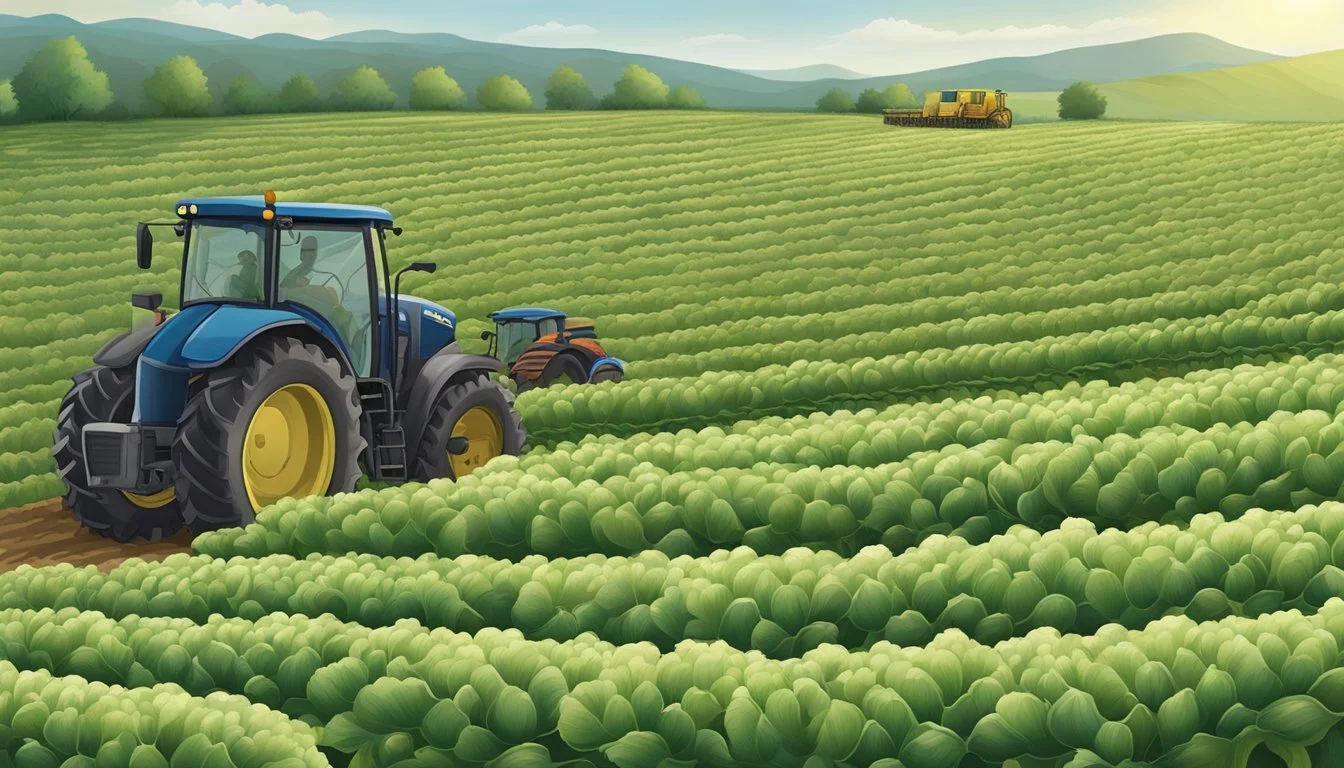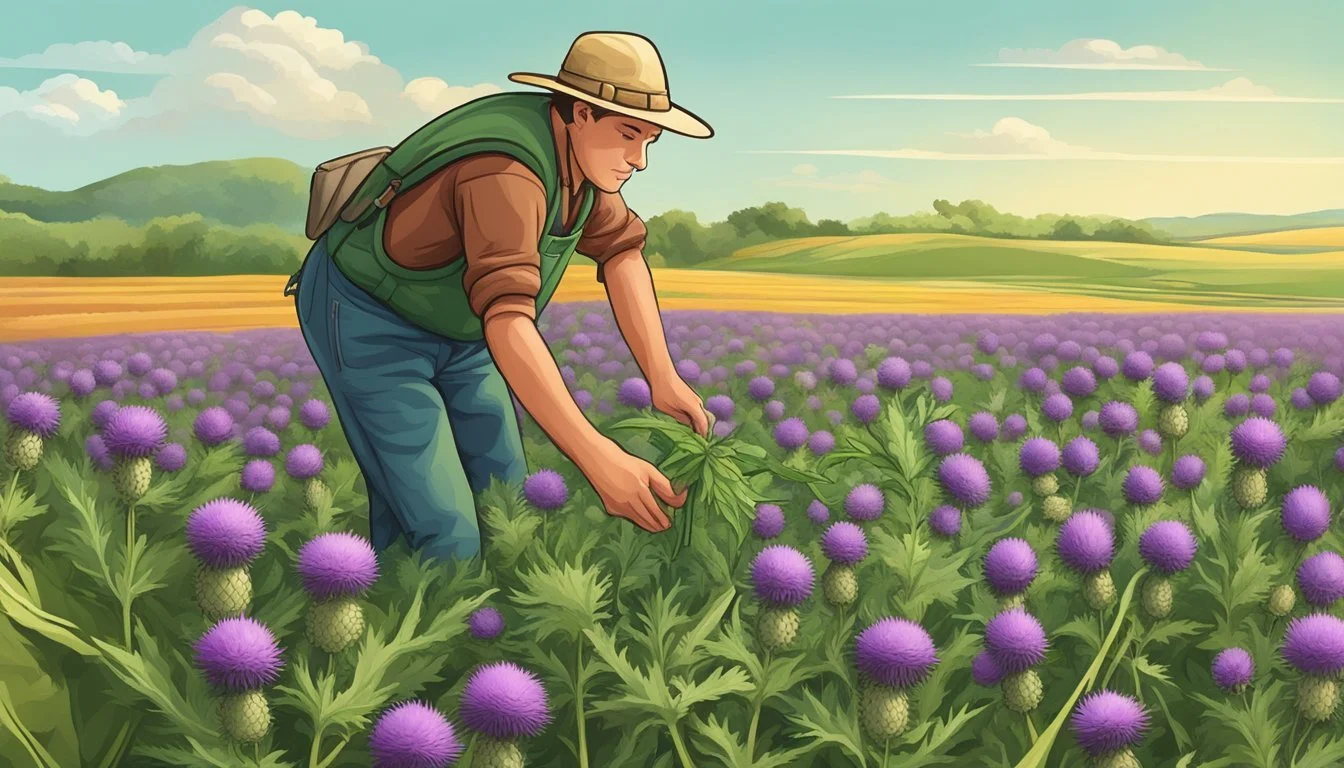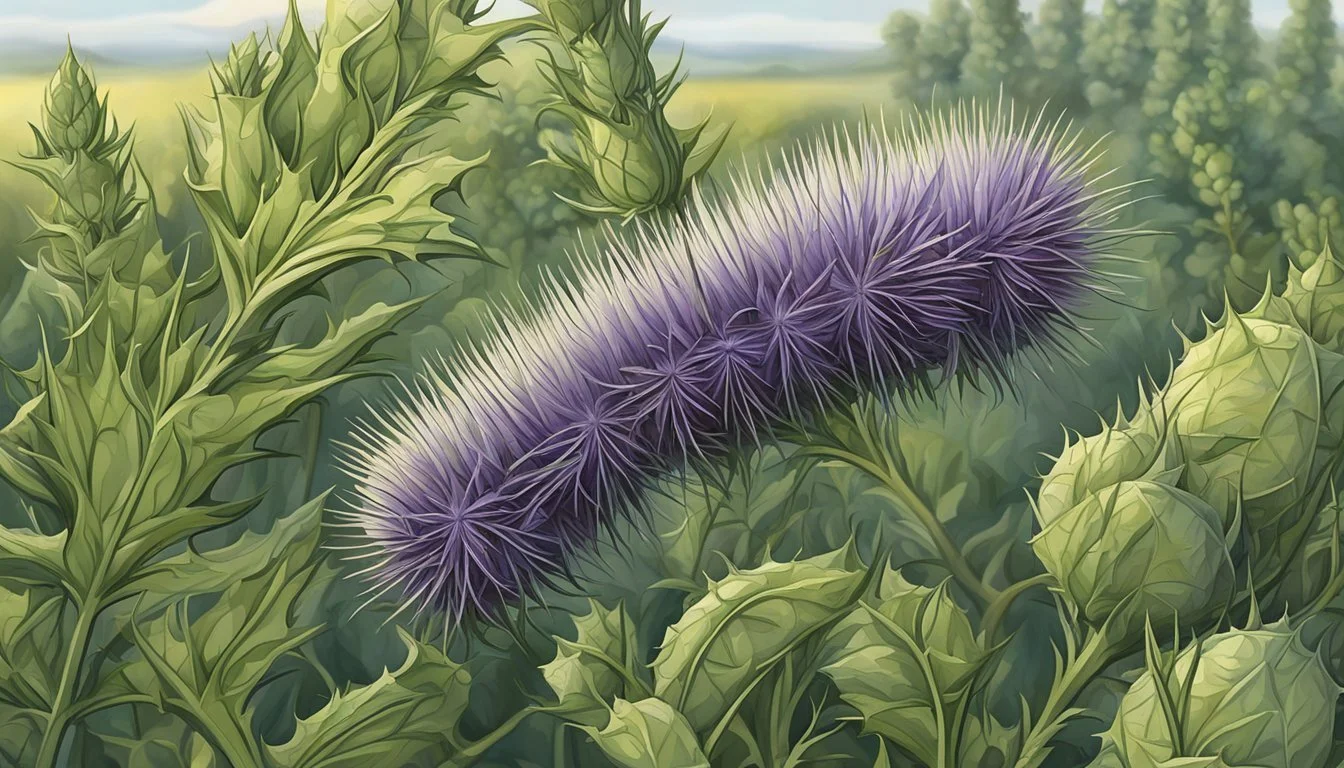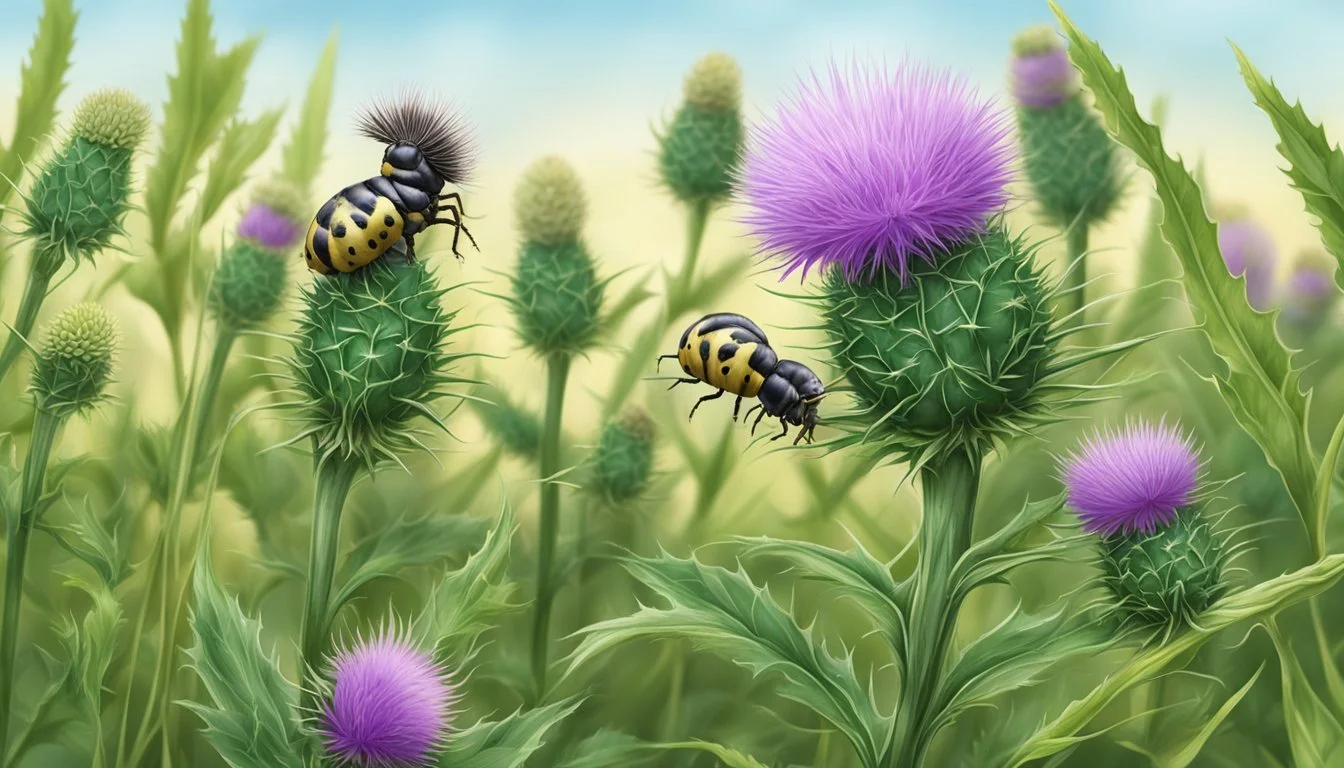Protecting Crops from Thistle Caterpillar
Effective Control Strategies
Thistle caterpillars, the larvae of the painted lady butterfly, pose a significant threat to various crops including soybeans and sunflowers. These caterpillars are known to congregate toward the edges of fields, particularly where Canada thistle, a common weed, is present. Farmers face the challenge of identifying and managing these pests before they reach levels that can cause substantial damage to their crops. Detecting early stages of infestation is crucial, as significant defoliation can lead to a loss in yield, affecting the agricultural economy.
Effective management of thistle caterpillar populations involves a combination of monitoring and timely intervention. Thresholds have been established to aid farmers in making treatment decisions; for instance, treatment is generally recommended when fields reach 30 percent defoliation during the vegetative stage or 20 percent during the reproductive stage. Integrated Pest Management (IPM) strategies emphasize the importance of these thresholds to prevent unnecessary pesticide use and to protect beneficial species within the ecosystem.
Various control methods ranging from biological agents to chemical treatments are available to address thistle caterpillar outbreaks. The use of Bacillus thuringiensis (Bt), a biological pesticide, has been found to work alongside other treatments, providing a means to suppress caterpillar populations while minimizing environmental impact. The adoption of natural remedies, such as neem oil, also offers a sustainable option for maintaining crop health and mitigating the effects of these herbivorous pests.
Identifying the Thistle Caterpillar
Identifying the thistle caterpillar correctly is crucial for protecting crops, as this pest can cause significant damage to a variety of plants.
Physical Characteristics of Thistle Caterpillar
The thistle caterpillar, the larval stage of the painted lady butterfly (Vanessa cardui), exhibits unique physical features that set it apart from other caterpillar species. These larvae typically have a presence marked by their black and brown coloration, and a distinctive yellow stripe running down the length of both sides of their body. Additionally, they are covered with spiny hairs that can easily distinguish them from other species. When it comes to size, thistle caterpillars can grow up to 1.5 inches in length when they reach maturity.
Lifecycle and Development
The life cycle of the painted lady butterfly begins with eggs laid singly on the host plant leaves. After hatching, the larvae, or thistle caterpillars, create webs around the leaves to protect themselves as they feed. This stage can last between two to four weeks. Through the process of pupation, they further develop into a chrysalis, hanging from the plant during the stage of metamorphosis. Eventually, the adult butterflies emerge with distinct mottled hindwings decorated with black spots, signifying the completion of their transformation from reproductive maturity.
Environmental Impact and Spread
The thistle caterpillar's presence in crop fields is influenced by both its migration patterns and the availability of host plants. Recognizing these factors is crucial for managing their impact on agriculture effectively.
Migration Patterns
Thistle caterpillars, the larval form of the painted lady butterfly, migrate annually. They do not overwinter in colder regions such as North Dakota or South Dakota, but instead, arrive in these areas from warmer climates like the southern US and Mexico. This migration is a key factor in the population dynamics of the species, with large numbers sometimes appearing in agricultural fields during growing seasons.
Host Range and Habitat
The host range of thistle caterpillars includes a variety of plants, but they show a preference for weeds such as Canada thistle. They will also utilize crops like sunflower and soybean, where they can cause significant damage. Canada, with its abundance of Canada thistle, often sees thistle caterpillars near field edges, feeding on the plants and sometimes moving into crops. The caterpillars are drawn to these areas by the availability of nectar and suitable host plants for laying eggs. Understanding the habitats that support thistle caterpillar populations is essential for monitoring and controlling their spread.
Damage caused by Thistle Caterpillars
Thistle caterpillars, the larval stage of the painted-lady butterfly, pose a significant threat to soybean crops. They cause damage by defoliating plants, which can impact yields if left unmanaged.
Effects on Soybean and Agriculture
Defoliation: This is the primary damage caused by thistle caterpillars, where they eat the leaves of soybean plants. During the vegetative stages (V3-V4) of soybean growth, this feeding can be particularly harmful. Serious infestations have the potential to reduce the crop canopy, which is vital for photosynthesis and plant health, leading to diminished pod set and ultimately affecting yield.
Agricultural Impact: The presence of thistle caterpillars in soybean fields necessitates close monitoring and, potentially, the application of insecticides. These interventions can increase production costs and require growers to carefully balance pest management with economic and environmental considerations.
Identifying Defoliation Signs
Visual Indicators: Farmers and agronomists can identify thistle caterpillar infestations by observing the leaves for webbing and the caterpillars themselves, which range from creamy white to gray-brown with a characteristically yellow line down their back.
Extent of Feeding: It is essential to note that while some defoliation is expected, it becomes a concern when it exceeds the threshold of approximately 20% defoliation during the pre-flowering stages of the soybean plants. Scouting for these caterpillars and assessing the damage can help in determining the necessity for intervention to protect the crop.
Monitoring and Scouting
To safeguard crops effectively during summer months, especially in Midwest states like Iowa and Minnesota, vigilant monitoring and scouting for thistle caterpillar activity is crucial. This involves carefully tracking populations and establishing clear treatment thresholds.
Detecting Thistle Caterpillar Activity
Farmers and agronomists should begin scouting for thistle caterpillar activity in June, the time when eggs and immature stages are likely to be present. Inspection should focus on the undersides of leaves for eggs and the presence of webbing—indicative of larval activity. The caterpillars often create shelters by rolling leaves and securing them with silk, which can be seen on plants such as soybean and sunflower. According to SDSU Extension, these shelters are a telltale sign of their presence.
Setting Treatment Thresholds
Treatment thresholds for thistle caterpillar are defined by the extent of defoliation observed in the field:
Vegetative Stage: Treatment is recommended if defoliation reaches 30%.
Reproductive Stage: Treatment is suggested at 20% defoliation.
These thresholds help determine when the economic costs of damage outweigh the costs of control measures. However, as noted by Iowa State University, populations rarely reach levels that require treatment. It is crucial to consider these thresholds before applying any control tactics to avoid unnecessary interventions.
Management and Control Strategies
In addressing thistle caterpillar infestations, it is essential to deploy effective management and control strategies to protect valuable crops such as corn and sunflowers. These strategies should comprise both biological and chemical methods, tailored to suit environmental conditions and reduce crop damage to acceptable levels.
Biological Control
Biological control involves using natural predators or pathogens to regulate the thistle caterpillar population. Fungi, such as entomopathogenic species, can infect and kill these pests under the right environmental conditions. Farmers should observe the presence of painted lady caterpillar corpses as an indication of biological control agents at work. It's important to note that this method can be highly effective when weather conditions support the proliferation of fungal pathogens.
Chemical Control
Chemical control, particularly using insecticides, represents a key strategy in controlling thistle caterpillar. Foliar insecticides may be necessary when caterpillar populations surpass economic threshold levels. However, due to the pest's spiny hairs, which offer some protection, it's critical to choose an insecticide to which the caterpillars are susceptible and to apply it correctly. Treatment recommendations are generally based on defoliation levels, with a threshold of 30 percent for vegetative stage crops and 20 percent for reproductive stage crops considered actionable for insect management. Proper application of insecticides can significantly mitigate the impact of these caterpillars on crops like sunflowers and corn, but farmers must always consider the potential environmental implications of the chemicals used.
Impact on Other Plant Species
The thistle caterpillar demonstrates significant adaptability, feeding on various plant species well beyond cultivated crops. This feeding behavior often occurs during the summer months, particularly in regions like the southern U.S., where the caterpillar's generations are more prolific.
Non-Crop Hosts and Weeds
Hosts: Thistle caterpillars are not exclusive to crop plants; they also target a range of non-crop hosts. Weeds such as Canada thistle act as natural reservoirs for these insects.
Weeds: Weeds play a crucial role in the life cycle of thistle caterpillars, especially as alternative food sources when crops are not available. The extensive webbing created by thistle caterpillars on these plants is a telltale sign of infestation.
Sunflowers: In the southern U.S. during the summer, sunflowers may host thistle caterpillars. These caterpillars use their webbing to bind leaves together, creating a protected habitat for feeding and development.
Weed Control: Effective weed management, particularly of non-crop hosts like Canada thistle, can help mitigate the impact of thistle caterpillars on other plant species by removing potential breeding and feeding grounds.
Potential Future Trends in Thistle Caterpillar Populations
Thistle caterpillar populations, which are the larval stage of the painted lady butterfly, are subject to change due to various factors. These factors include environmental conditions, and advancements in research and control methods.
Research and Developments in Pest Control
Research into controlling thistle caterpillar populations has been advancing. Scientists aim to understand the eating habits and life cycle of the painted lady butterfly to create more effective control strategies. One aspect of this is studying how environmental conditions such as temperature, precipitation, and the availability of their preferred host plants (like Canada thistle) affect population dynamics.
Development in pest control often focuses on integrating strategies that reduce the need for chemical treatments. This includes the augmentation of natural predators and the handling of crop borders to manage the ingress of thistle caterpillars. Biological control agents are being evaluated for their efficacy against thistle caterpillar populations, which could lead to less chemical use and a more environmentally-friendly control method.
Research findings guide the development of prediction models to forecast population surges. These models consider variables like seasonal weather patterns and historical infestation data to help prepare for and mitigate against prospective outbreaks. As this research evolves, it may lead to the creation of pest-resistant crop varieties and more precise application of insecticides when populations reach critical thresholds.
Conclusion
Thistle caterpillars, the larvae of the painted lady butterfly, are sporadic pests that have a preference for Canada thistle but can impact a variety of crops, such as soybeans and sunflowers. Effective management hinges on early detection and intervention when infestation levels warrant it.
Monitoring is crucial, with a guideline being treatment upon reaching 30 percent defoliation in the vegetative stage or 20 percent during the reproductive stage for crops. This highlights the need for growers to be vigilant in observing their fields, particularly at the edges where these caterpillars tend to aggregate.
Cultural practices play a role in mitigating the risk, with crop rotation and maintaining field hygiene reducing the likelihood of severe infestations. Biological controls and selective insecticides may be used as part of an integrated pest management strategy, applying treatments judiciously to minimize impact on beneficial species and prevent resistance development.
By amalgamating prevention tactics with responsive control measures, farmers can protect their crops from the destructive feeding of thistle caterpillars and maintain healthy crop yields. It is essential that growers stay informed on pest management trends and seek advice from agricultural extension services for up-to-date recommendations tailored to their local conditions.
Frequently Asked Questions
Thistle caterpillars can impact crop yield by defoliating soybean fields and other crops. Below, farmers and gardeners can find concise and clear answers to common queries regarding how to manage and understand thistle caterpillar challenges.
How can farmers safeguard their soybean fields from thistle caterpillars?
They should monitor their fields regularly for signs of infestation and consider applying protective measures if 30 percent defoliation is observed during the vegetative stage or 20 percent during the reproductive stage of soybeans.
Are thistle caterpillars harmful to humans or livestock?
Thistle caterpillars are not considered harmful to humans or livestock; they mainly affect plant health by feeding on the foliage, especially in crops like soybeans.
What are the stages of the thistle caterpillar's life cycle?
The thistle caterpillar's life cycle includes four stages: egg, larva, pupa, and adult butterfly. They pass through these stages before maturing into the painted lady butterfly.
How can one identify a thistle caterpillar among other species?
Thistle caterpillars can be identified by their distinctive spiny appearance and their tendency to feed primarily on Canada thistle foliage, leaving stems and midribs intact.
What natural methods are effective at preventing caterpillar infestations in crops?
Natural methods to prevent infestations include encouraging beneficial insects that prey on caterpillars and applying biological treatments like Bacillus thuringiensis (Bt).
What type of insecticide should be used to control thistle caterpillar populations?
Chemical controls should be a last resort, but when necessary, farmers may use foliar insecticides. However, if caterpillars are near the end of their larval stage or appear infected with a virus, foliar insecticides may not be warranted.







